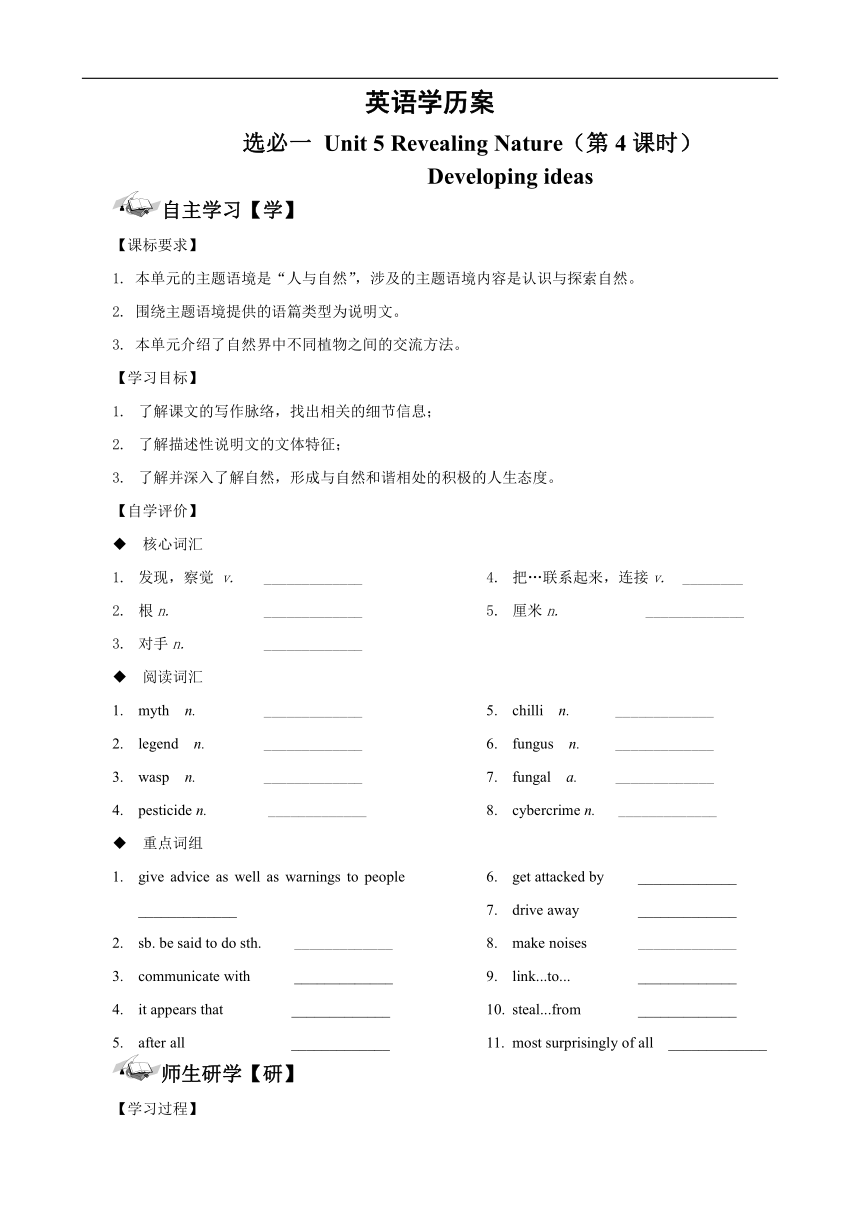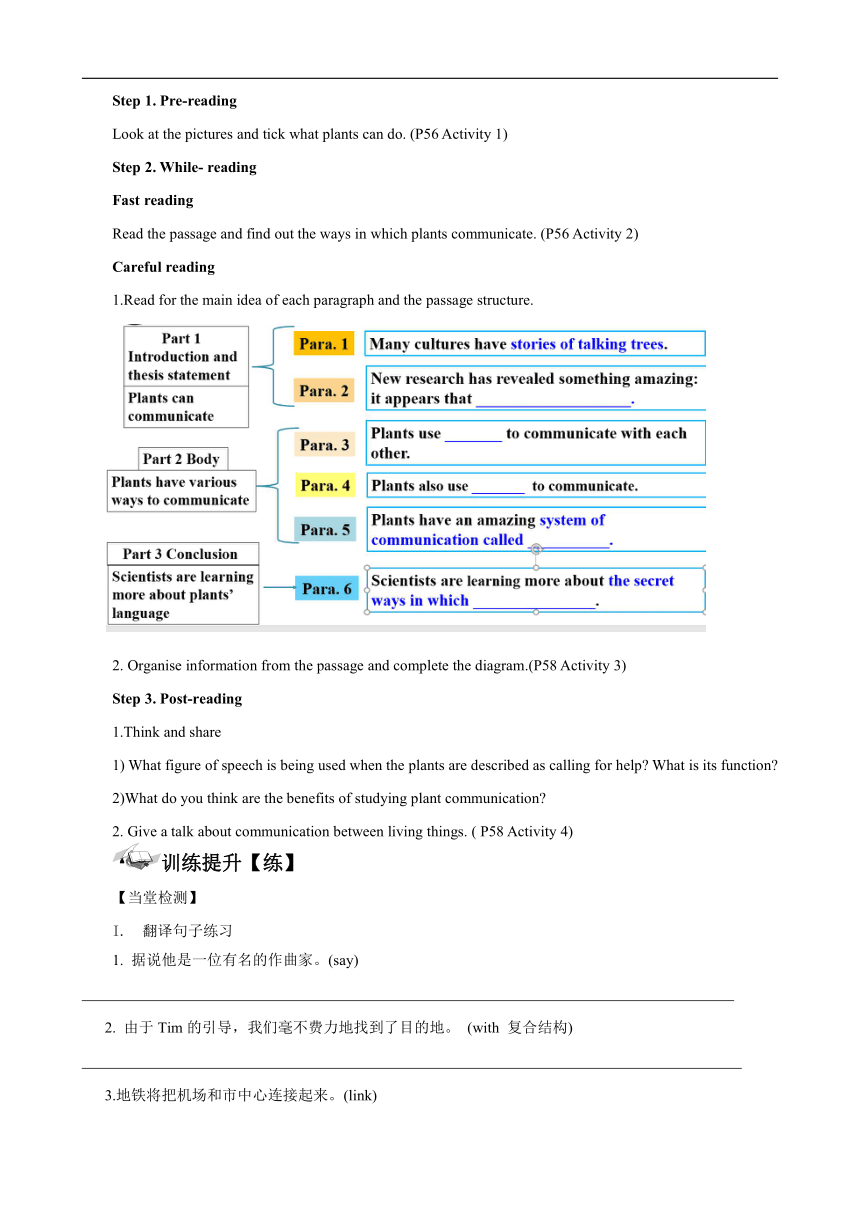外研版(2019)选择性必修第一册Unit 5 Revealing Nature Developing ideas学历案(无答案)
文档属性
| 名称 | 外研版(2019)选择性必修第一册Unit 5 Revealing Nature Developing ideas学历案(无答案) |  | |
| 格式 | docx | ||
| 文件大小 | 102.9KB | ||
| 资源类型 | 教案 | ||
| 版本资源 | 外研版(2019) | ||
| 科目 | 英语 | ||
| 更新时间 | 2024-03-20 08:14:31 | ||
图片预览


文档简介
英语学历案
选必一 Unit 5 Revealing Nature(第4课时)
Developing ideas
自主学习【学】
【课标要求】
1. 本单元的主题语境是“人与自然”,涉及的主题语境内容是认识与探索自然。
2. 围绕主题语境提供的语篇类型为说明文。
3. 本单元介绍了自然界中不同植物之间的交流方法。
【学习目标】
了解课文的写作脉络,找出相关的细节信息;
了解描述性说明文的文体特征;
了解并深入了解自然,形成与自然和谐相处的积极的人生态度。
【自学评价】
核心词汇
发现,察觉 v. _____________
根n. _____________
对手n. _____________
把…联系起来,连接v. ________
厘米n. _____________
阅读词汇
myth n. _____________
legend n. _____________
wasp n. _____________
pesticide n. _____________
chilli n. _____________
fungus n. _____________
fungal a. _____________
cybercrime n. _____________
重点词组
give advice as well as warnings to people _____________
sb. be said to do sth. _____________
communicate with _____________
it appears that _____________
after all _____________
get attacked by _____________
drive away _____________
make noises _____________
link...to... _____________
steal...from _____________
most surprisingly of all _____________
师生研学【研】
【学习过程】
Step 1. Pre-reading
Look at the pictures and tick what plants can do. (P56 Activity 1)
Step 2. While- reading
Fast reading
Read the passage and find out the ways in which plants communicate. (P56 Activity 2)
Careful reading
1.Read for the main idea of each paragraph and the passage structure.
2. Organise information from the passage and complete the diagram.(P58 Activity 3)
Step 3. Post-reading
1.Think and share
1) What figure of speech is being used when the plants are described as calling for help What is its function
2)What do you think are the benefits of studying plant communication
2. Give a talk about communication between living things. ( P58 Activity 4)
训练提升【练】
【当堂检测】
翻译句子练习
1. 据说他是一位有名的作曲家。(say)
2. 由于Tim的引导,我们毫不费力地找到了目的地。 (with 复合结构)
3.地铁将把机场和市中心连接起来。(link)
4.随着年龄的增长,我们的大脑会因为很多原因而衰退。(decline)
________________________________________________________________________________________
阅读理解
(2021·全国·高考真题)I have worked as a keeper at the National Zoo, Paris for 11 years. Spot and Stripe are the first tiger cubs that have ever been born here. Globally, a third of Sumatran cubs in zoos don't make it to adulthood, so I decided to give them round-the-clock care at home.
I've got two children—the younger one, Kynan, was extremely happy about the tigers arriving - but all of us really looked forward to being part of their lives and watching them grow. I wasn't worried about bringing them into my home with my wife and kids. These were cubs. They weighed about 2.5 kg and were so small that there was absolutely no risk.
As they grew more mobile, we let them move freely around the house during the day, but when we were asleep we had to contain them in a large room, otherwise they'd get up to mischief. We'd come down in the morning to find they'd turned the room upside down, and left it looking like a zoo.
Things quickly got very intense due to the huge amount of energy required to look after them. There were some tough times and I just felt extremely tired. I was grateful that my family was there to help. We had to have a bit of a production line going, making up “tiger milk”, washing baby bottles, and cleaning the floors.
When Spot and Stripe were four months old, they were learning how to open doors and jump fences, and we knew it really was time for them to go. It was hard for us to finally part with them. For the first few days, Kynan was always a bit disappointed that the cubs weren't there.
I'm not sad about it. I'm hands-on with them every day at the zoo, and I do look back very fondly on the time that we had them.
5.Why did the author bring the tiger cubs home
A.To ensure their survival. B.To observe their differences.
C.To teach them life skills. D.To let them play with his kids.
6.What do the underlined words “get up to mischief” mean in paragraph 3
A.Behave badly. B.Lose their way. C.Sleep soundly. D.Miss their mom.
7.What did the author think of raising the tiger cubs at home
A.Boring. B.Tiring. C.Costly. D.Risky.
8.Why did the author decide to send Spot and Stripe back to the zoo
A.They frightened the children. B.They became difficult to contain.
C.They annoyed the neighbours. D.They started fighting each other.
七选五
Have you ever heard of the pawpaw (番木瓜) If not, do not feel bad. Most Americans do not know of the fruit, although it is native to the US. Once, however, it was one of the most popular fruits in North America. ___1___
A pawpaw is a tropical-like fruit that grows on trees found all over the eastern US. It's also the largest edible (可食用的) fruit native to the US. It is similar to a typical mango in size and has a dull green-colored skin. Most people agree that the pawpaw tastes like a combination of a banana and a mango. ___2___
At one time, it could be found as far west as Nebraska. ___3___ The fruit has a very short harvest season, from two to three weeks in September and October.
___4___ It requires a very special environment — low, wet areas that sometimes flood. In addition, the fruit is good to eat for only two to three days after harvest. This makes it hard to sell anywhere distant from the pawpaw tree it came from.
Planters are again growing pawpaw trees and harvesting the fruit. ___5___ At a recent festival in Maryland, farmers showed different products, such as pawpaw jams, pies and beer.
A.The pawpaw has never been sold commercially.
B.Most people are very surprised by its sweet taste.
C.Maybe the pawpaw will show up soon at a market near you.
D.It also grows along the East Coast from New York to Florida.
E.Happily, some people are trying to return it to its former position in American foods.
F.In several states, Farmers have organized "pawpaw festivals" to reintroduce people to the food.
G.Farmers are trying to grow kinds of pawpaw that will be easier to ship and sell commercially.
【布置作业】
_______________________________________________________________________________________
师生总结【结】
选必一 Unit 5 Revealing Nature(第4课时)
Developing ideas
自主学习【学】
【课标要求】
1. 本单元的主题语境是“人与自然”,涉及的主题语境内容是认识与探索自然。
2. 围绕主题语境提供的语篇类型为说明文。
3. 本单元介绍了自然界中不同植物之间的交流方法。
【学习目标】
了解课文的写作脉络,找出相关的细节信息;
了解描述性说明文的文体特征;
了解并深入了解自然,形成与自然和谐相处的积极的人生态度。
【自学评价】
核心词汇
发现,察觉 v. _____________
根n. _____________
对手n. _____________
把…联系起来,连接v. ________
厘米n. _____________
阅读词汇
myth n. _____________
legend n. _____________
wasp n. _____________
pesticide n. _____________
chilli n. _____________
fungus n. _____________
fungal a. _____________
cybercrime n. _____________
重点词组
give advice as well as warnings to people _____________
sb. be said to do sth. _____________
communicate with _____________
it appears that _____________
after all _____________
get attacked by _____________
drive away _____________
make noises _____________
link...to... _____________
steal...from _____________
most surprisingly of all _____________
师生研学【研】
【学习过程】
Step 1. Pre-reading
Look at the pictures and tick what plants can do. (P56 Activity 1)
Step 2. While- reading
Fast reading
Read the passage and find out the ways in which plants communicate. (P56 Activity 2)
Careful reading
1.Read for the main idea of each paragraph and the passage structure.
2. Organise information from the passage and complete the diagram.(P58 Activity 3)
Step 3. Post-reading
1.Think and share
1) What figure of speech is being used when the plants are described as calling for help What is its function
2)What do you think are the benefits of studying plant communication
2. Give a talk about communication between living things. ( P58 Activity 4)
训练提升【练】
【当堂检测】
翻译句子练习
1. 据说他是一位有名的作曲家。(say)
2. 由于Tim的引导,我们毫不费力地找到了目的地。 (with 复合结构)
3.地铁将把机场和市中心连接起来。(link)
4.随着年龄的增长,我们的大脑会因为很多原因而衰退。(decline)
________________________________________________________________________________________
阅读理解
(2021·全国·高考真题)I have worked as a keeper at the National Zoo, Paris for 11 years. Spot and Stripe are the first tiger cubs that have ever been born here. Globally, a third of Sumatran cubs in zoos don't make it to adulthood, so I decided to give them round-the-clock care at home.
I've got two children—the younger one, Kynan, was extremely happy about the tigers arriving - but all of us really looked forward to being part of their lives and watching them grow. I wasn't worried about bringing them into my home with my wife and kids. These were cubs. They weighed about 2.5 kg and were so small that there was absolutely no risk.
As they grew more mobile, we let them move freely around the house during the day, but when we were asleep we had to contain them in a large room, otherwise they'd get up to mischief. We'd come down in the morning to find they'd turned the room upside down, and left it looking like a zoo.
Things quickly got very intense due to the huge amount of energy required to look after them. There were some tough times and I just felt extremely tired. I was grateful that my family was there to help. We had to have a bit of a production line going, making up “tiger milk”, washing baby bottles, and cleaning the floors.
When Spot and Stripe were four months old, they were learning how to open doors and jump fences, and we knew it really was time for them to go. It was hard for us to finally part with them. For the first few days, Kynan was always a bit disappointed that the cubs weren't there.
I'm not sad about it. I'm hands-on with them every day at the zoo, and I do look back very fondly on the time that we had them.
5.Why did the author bring the tiger cubs home
A.To ensure their survival. B.To observe their differences.
C.To teach them life skills. D.To let them play with his kids.
6.What do the underlined words “get up to mischief” mean in paragraph 3
A.Behave badly. B.Lose their way. C.Sleep soundly. D.Miss their mom.
7.What did the author think of raising the tiger cubs at home
A.Boring. B.Tiring. C.Costly. D.Risky.
8.Why did the author decide to send Spot and Stripe back to the zoo
A.They frightened the children. B.They became difficult to contain.
C.They annoyed the neighbours. D.They started fighting each other.
七选五
Have you ever heard of the pawpaw (番木瓜) If not, do not feel bad. Most Americans do not know of the fruit, although it is native to the US. Once, however, it was one of the most popular fruits in North America. ___1___
A pawpaw is a tropical-like fruit that grows on trees found all over the eastern US. It's also the largest edible (可食用的) fruit native to the US. It is similar to a typical mango in size and has a dull green-colored skin. Most people agree that the pawpaw tastes like a combination of a banana and a mango. ___2___
At one time, it could be found as far west as Nebraska. ___3___ The fruit has a very short harvest season, from two to three weeks in September and October.
___4___ It requires a very special environment — low, wet areas that sometimes flood. In addition, the fruit is good to eat for only two to three days after harvest. This makes it hard to sell anywhere distant from the pawpaw tree it came from.
Planters are again growing pawpaw trees and harvesting the fruit. ___5___ At a recent festival in Maryland, farmers showed different products, such as pawpaw jams, pies and beer.
A.The pawpaw has never been sold commercially.
B.Most people are very surprised by its sweet taste.
C.Maybe the pawpaw will show up soon at a market near you.
D.It also grows along the East Coast from New York to Florida.
E.Happily, some people are trying to return it to its former position in American foods.
F.In several states, Farmers have organized "pawpaw festivals" to reintroduce people to the food.
G.Farmers are trying to grow kinds of pawpaw that will be easier to ship and sell commercially.
【布置作业】
_______________________________________________________________________________________
师生总结【结】
